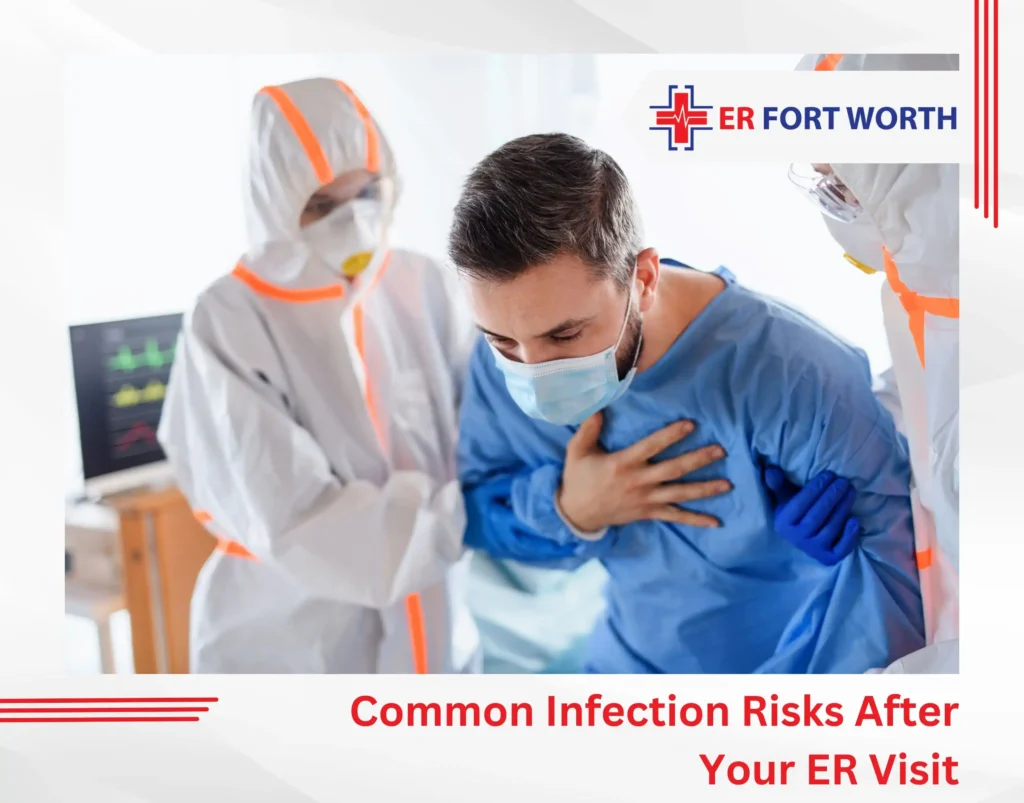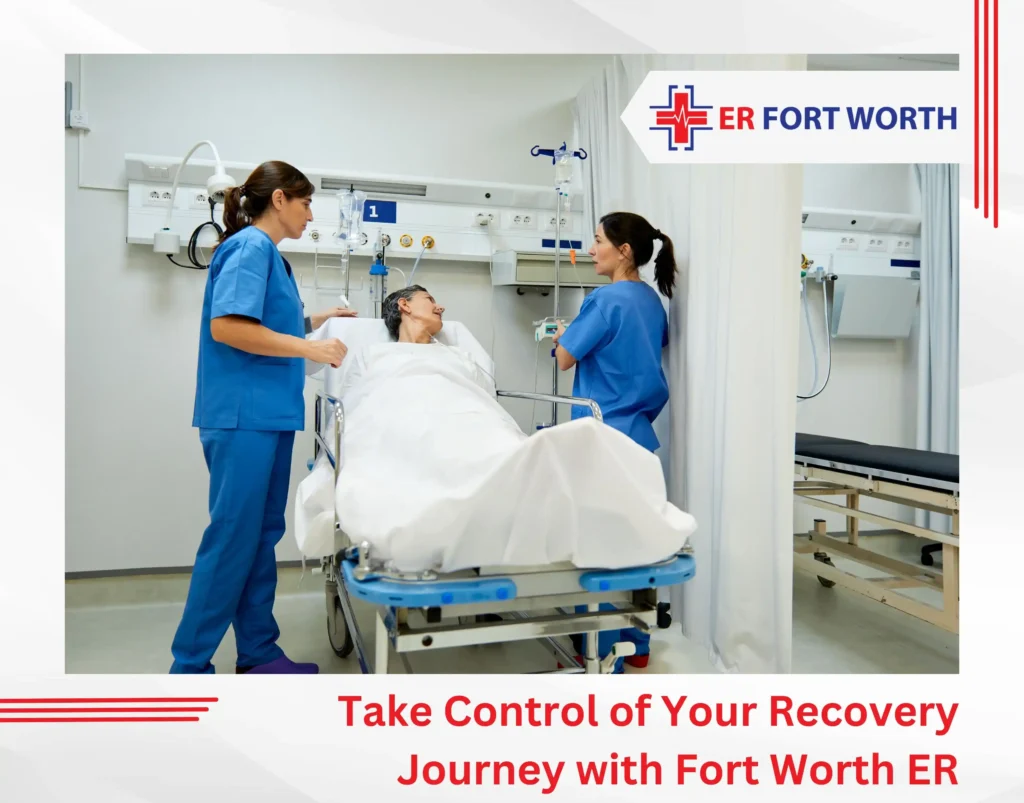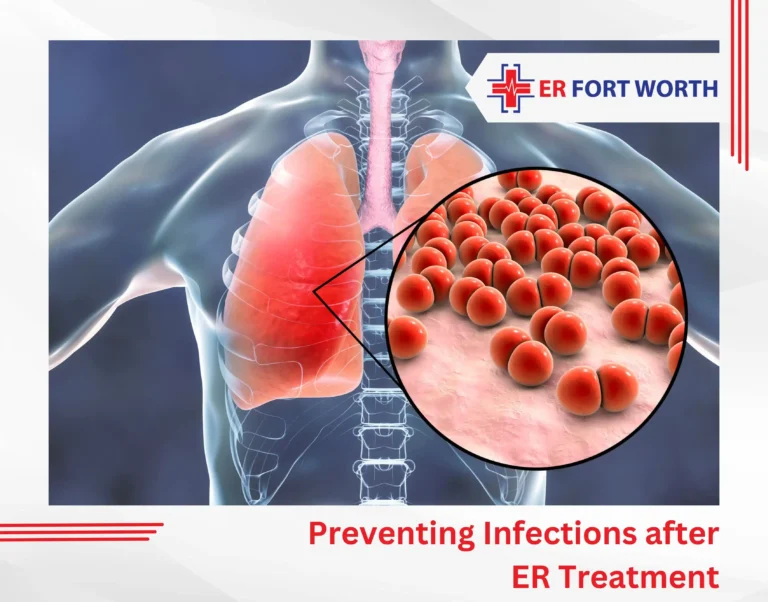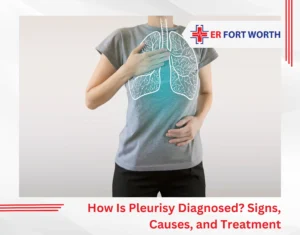Your ER wound looks clean now, but up to 10% of emergency room patients develop infections despite proper treatment. ER infection prevention starts the moment you leave the facility doors. Small oversights in wound care or medication can transform a healing injury into a serious infection.
The difference between normal healing and infection often comes down to recognizing warning signs. Untreated infections lead to longer hospital stays, increased medical costs, and potential complications. Our emergency physicians provide post-treatment care for infections when caught early.
This guide provides tailored aftercare instructions to reduce infection risks and facilitate pave the way for a smooth recovery.
Common Infection Risks After Your ER Visit

After leaving the hospital or emergency room, your body remains vulnerable to several infection types. Effective ER infection prevention requires knowing what to watch for during post-treatment care.
Surgical Site Infections (SSIs)
These affect the area where a procedure took place. If you underwent emergency surgery for gastrointestinal conditions or pediatric issues, watch for fever, redness, swelling, pain, or cloudy drainage from the wound site.
Urinary Tract Infections (UTIs)
Often linked to catheter use in medical procedures, UTIs can affect any part of your urinary system. Warning signs include burning during urination, frequent urge to urinate, and cloudy or strong-smelling urine.
Respiratory Infections
Patients with pre-existing breathing conditions or those who require ventilation support face higher risks. Pneumonia can develop days after treatment, especially in vulnerable individuals.
Bloodstream Infections (BSIs)
These can occur when bacteria enter through IV lines or central catheters used during emergency care. Symptoms include fever, chills, and potentially sepsis, which is a life-threatening condition requiring immediate attention.
Other Infections
Gastroenteritis affecting the digestive system like diarrhea and vomiting, and skin/soft tissue infections can also develop after ER visits due to exposure to various pathogens in the emergency environment.
Understanding these infection risks helps you recognize early warning signs and seek prompt medical attention before complications develop.
Essential Infection Prevention Tips for Patients
Taking an active role in your post-ER infection prevention significantly reduces your infection risk. Here are five critical steps to protect your health during recovery:
1. Practice Diligent Hand Hygiene
- Wash hands with soap and water for at least 20 seconds, especially after using the restroom, before eating, and after touching potentially contaminated surfaces.
- Use hand sanitizer with at least 60% alcohol when soap and water aren’t available.
- Remember that proper hand cleaning is your first defense against post-treatment infections.
2. Follow Proper Wound Care
- Adhere strictly to the emergency room’s verbal and written wound care instructions.
- Keep all wounds clean and dry as directed.
- Always wash hands before and after touching wounds or changing dressings.
- Monitor for infection signs: increased redness, swelling, pain, warmth, unusual drainage, or fever.
3. Manage Medical Devices Carefully
- For urinary catheters: clean the insertion site with soap and water, empty the drainage bag regularly, and prevent tube blockage.
- For IV sites: keep dressings clean and dry, and report any pain or redness immediately.
- Follow all specific care instructions provided by your emergency care team.
4. Take Medications Correctly
- Complete the full course of any prescribed antibiotics, even if you start feeling better.
- Take medications exactly as directed regarding timing and food requirements.
- Understand each medication’s purpose and potential side effects.
- Contact your provider with any medication questions or concerns.
5. Monitor for Infection Warning Signs
- Check regularly for fever, chills, increased pain, new redness/swelling, unusual drainage, or general unwellness.
- Don’t hesitate to seek medical advice if you notice any potential infection symptoms.
- Early detection leads to faster treatment and better outcomes.
Also Read: Post ER Recovery: Steps to Ensure a Smooth Healing Process
Importance of Post-Treatment Care and Follow-Up

Beyond immediate infection prevention measures, your overall post-treatment care approach significantly impacts infection risks after an ER visit. ER infection prevention extends well beyond wound care to include several key recovery components.
Rest and Recovery
Rest serves as a vital recovery component, allowing your body to direct energy toward tissue repair and infection prevention. After emergency treatment:
- Give your body adequate downtime to strengthen your immune response.
- Avoid strenuous activities that might stress wounds or surgical sites.
- Create a comfortable recovery environment that promotes healing.
- Balance rest with gentle movement as recommended by your provider.
Nutrition and Hydration
What you eat and drink directly affects your body’s infection-fighting capabilities:
- Maintain a diet rich in fruits, vegetables, and lean protein to support tissue repair.
- Focus on vitamin-rich foods that bolster immune function.
- Drink plenty of fluids to help your body flush toxins and maintain proper circulation.
- Limit alcohol and caffeine, which can interfere with medication effectiveness and hydration.
Follow-Up Appointment Attendance
Perhaps the most crucial aspect of post-treatment care is attending all scheduled follow-up appointments:
- These visits allow healthcare providers to monitor recovery progress.
- Doctors can check for early infection signs before they become serious.
- You can address new concerns or questions about your healing process.
- Medication adjustments can be made if your current regimen isn’t working effectively.
Never skip follow-up appointments, even if you feel better. Many infections develop gradually, and professional evaluation often catches problems before they become evident to you.
Navigating Patient Concerns After ER Treatment
Many patients report unexpected complications after emergency room visits. These concerns frequently appear in online forums, where patients share their post-treatment experiences:
- Development of yeast infections following antibiotic treatment
- Unexpected side effects from prescribed medications
- Lingering pain or discomfort that doesn’t subside
- Secondary infections at treatment sites
Infections aren’t uncommon after certain procedures, as your body remains vulnerable during healing. Antibiotics, while essential for treating bacterial infections, can disrupt your natural microbiome balance, potentially leading to secondary infections like yeast overgrowth. Persistent pain might signal complications or simply reflect your body’s natural healing process; but never ignore it.
Take Control of Your Recovery Journey with Fort Worth ER

At ER of Fort Worth, supporting your complete recovery is our priority. We understand the anxiety that can accompany post-emergency treatment and the importance of addressing concerns before they become serious problems.
Our team remains available to answer questions during your healing process. Whether you’re seeking guidance or experiencing new symptoms, we provide expert care because your well-being drives everything we do. Remember that proper ER infection prevention continues throughout your entire healing journey.
FAQs
How soon after an ER visit should I follow up with my doctor?
The timing for a follow-up appointment depends on the reason for your ER visit and the treatment you received. Generally, it’s a good idea to follow up with your primary care physician within a few days after your ER visit. For certain conditions, like injuries or infections, a sooner follow-up might be necessary to ensure proper healing and recovery.
Can I use over-the-counter antibiotic ointments on my wound?
While it might seem like a good idea, it’s best to follow the specific instructions provided by the ER staff regarding wound care, including the use of topical antibiotics.
What should I do if I miss a dose of my prescribed antibiotics?
If you miss a dose of your antibiotics, take it as soon as you remember. However, if it is almost time for your next dose, skip the missed dose and continue with your regular dosing schedule. Do not take a double dose to make up for the missed one.
When are you most at risk for infection after surgery?
Surgical wound infections typically occur within the first 30 days following surgery. Signs of an infection may include the presence of pus, redness, pain, or a warm sensation around the wound. Additionally, you could experience symptoms such as fever and general feelings of illness.
What happens if you get an infection after back surgery?
An infection after back surgery can cause complications that may affect your recovery.If untreated, infections can spread, leading to more serious conditions such as abscess formation or sepsis.
What are the signs that a surgical screw is coming loose?
Signs of a loose surgical screw include increased pain, swelling, redness, or unusual sensations like clicking or instability near the surgical site. If you suspect this, contact your healthcare provider promptly




